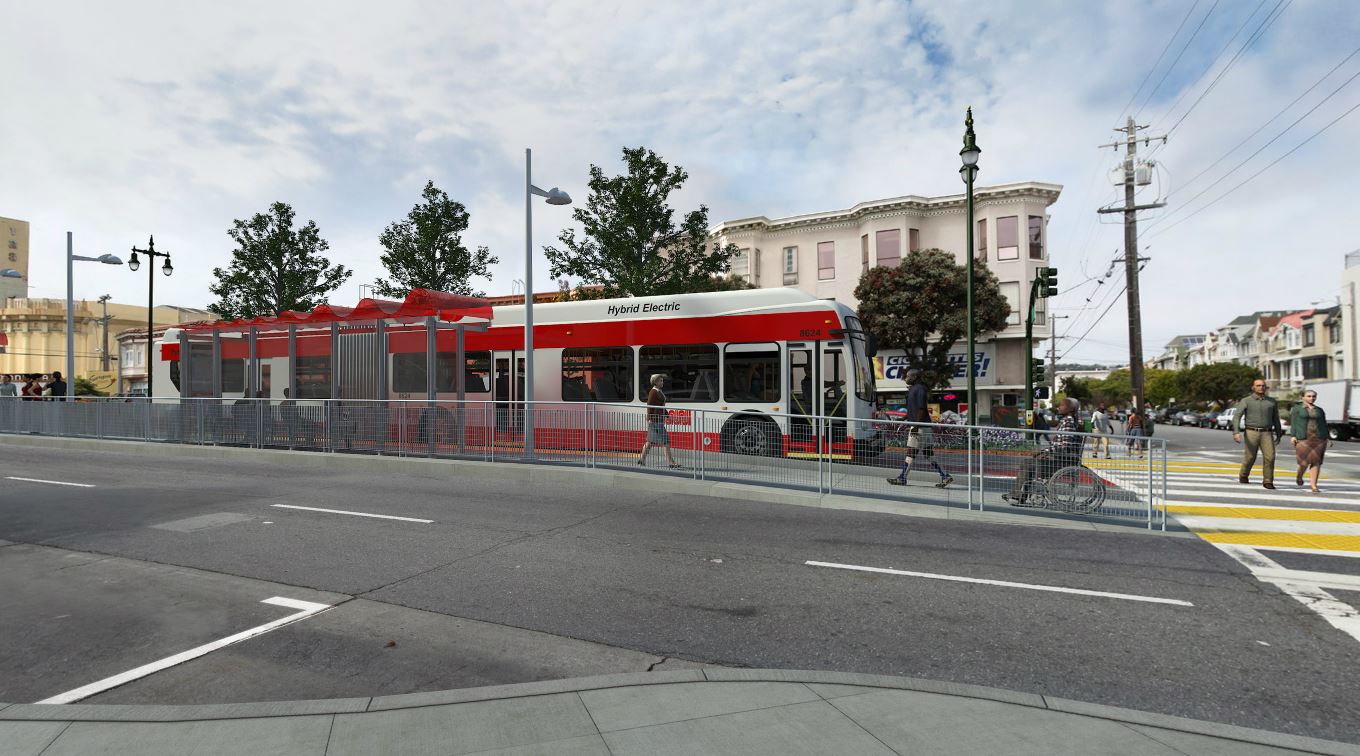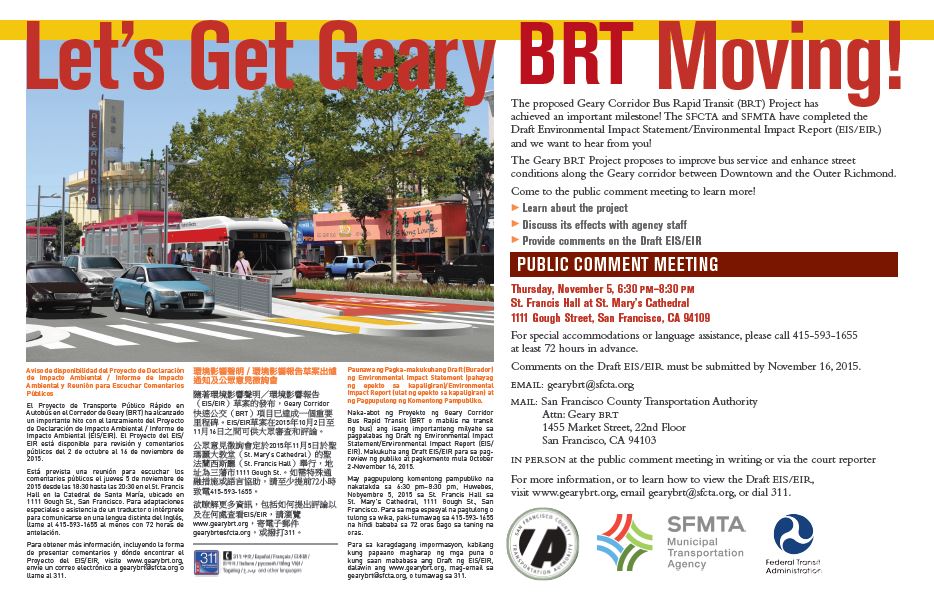Detail from a project rendering showing Geary BRT in operation.
The Geary Bus Rapid Transit project is a comprehensive proposal to improve transit and safety along Geary, and it’s now on its way to becoming a reality for the bus routes’ 55,000 daily riders.
Earlier this month, along with our sister agency, the San Francisco County Transportation Authority (SFCTA), we released the Geary BRT Draft Environmental Document. This marked the beginning of the public review and comment period.
After years of analysis and multiple rounds of outreach, the SFCTA and SFMTA are presenting their findings on the benefits and impacts of Geary BRT, including a staff-recommended alternative design that benefits people walking, taking transit, and driving along the corridor.
The proposed recommendation for Geary BRT would reduce travel times by 10 to 15 minutes, provide 20 percent more reliable service and improve pedestrian safety and access.
Now it’s time to hear from you! Below gives you an idea of what to expect when reviewing the Draft Environmental Document, how to access it and how to comment.
Bus information cards like this can be found in all Geary buses and shelters.
About the Draft Environmental Document
While the environmental document may not be the most exciting read, it ensures that we’re measuring all the potential impacts and benefits of the project and taking into account the needs of the surrounding communities.
The document identifies project effects in a range of subject areas for each alternative, including:
- Transit
- Traffic
- Parking
- Pedestrian Conditions
- Cultural Resources (such as historic landmarks)
- Biological Resources (such as trees and soil)
Each chapter compares the conditions from when the analysis began (2012) to the conditions when the project is complete (2020), and into the future in 2035, looking at the difference with and without the project. In some cases where potentially negative effects are identified, the analysis also identifies measures to mitigate those impacts.
For more information, or to review the document, visit www.gearybrt.org. Printed copies of the Draft EIS/EIR are available for review at the locations listed on the site, or you may purchase a printed copy from the SFCTA Front Desk at 1455 Market Street, 22nd Floor. Please call ahead at (415) 522-4800 to get pricing and to ensure availability.
How to Provide Feedback
The 45-day public review period began Oct.2 and ends Nov. 16. The primary purpose of the review period is to provide an opportunity to submit comments on the contents of the Draft Environmental Document.
As part of the public review process, the project team will host a public comment meeting at 6:30 p.m. on Nov. 5, at St. Francis Hall in the St. Mary’s Cathedral.
The meeting will provide an opportunity to review project information, discuss the project with staff and provide comments in writing or verbally. Comments can also be sent via email to geartybrt@sfcta.org or mail to:
Attn: Geary BRT EIS/EIR
San Francisco County Transportation Authority
1455 Market Street, 22nd Floor
San Francisco, CA 94103
If your organization is interested in learning more and having SFMTA and SFCTA staff present on the contents of the Draft Environmental Document, please email gearybrt@sfcta.org or call 415-522-4836. For more information, please visit www.gearybrt.org.
I provided a comment. What’s Next?
Anyone interested in the project is encouraged to check out the Environmental Document and leave comments. The project team will review and develop a response to every comment received and may update or perform additional analysis based on the feedback received. All comments and responses will be published in the Final Environmental Document, expected to be completed in the spring of 2016.
These comments are important, not just to ensure that the Environmental Document contains a complete analysis of project benefits and impacts, but to inform the decision-makers of the perspectives and issues raised by community groups and members of the public. Once the Final Environmental Document is complete, both the SFCTA and SFMTA Boards will need to approve the Geary BRT project and select a preferred alternative before the project can be implemented. Your comments will be provided to both boards as they make their decisions on the project.
The sheer amount of data and information in the Environmental Document can be daunting, but it reflects the many years of analysis and extensive outreach required of a project of this magnitude. The project team encourages you to check out the sections that are of interest to you, or just review the executive summary, and is looking forward to your feedback! Stay tuned for a follow-up on what’s next for Geary BRT. Let’s get Geary BRT moving!

